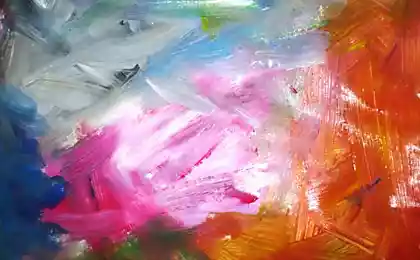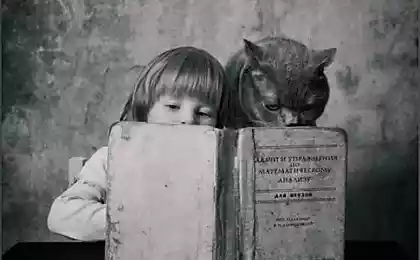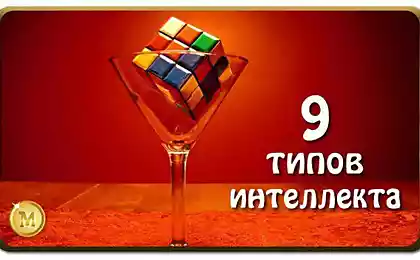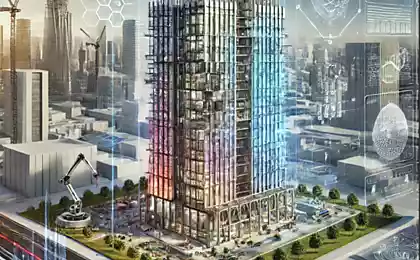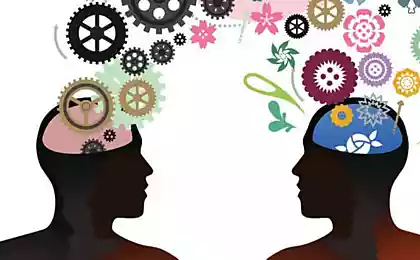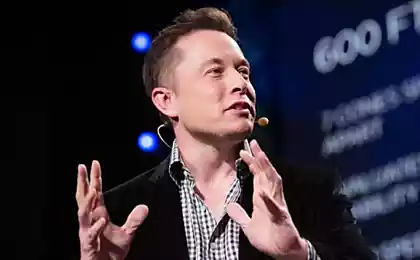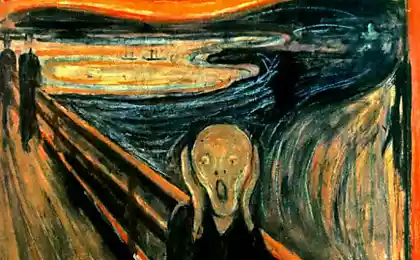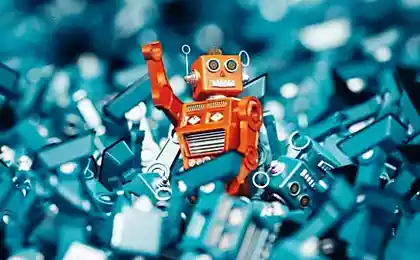2017
Path to the intellect. Step one. The overall picture
The article is an attempt to understand what intelligence is and to explain in simple terms the principles of its construction and implementation. The concept of "intelligence" generates fog even in the minds of intelligent people. As a rule, everyone understands Intellect so that he "thinks like a man." Having in mind the formal aspect of thinking. But a man can think not only formally (logically), but also emotionally, as well as an abstract (not to be confused with logic), but also sensory (specifically).
Many amateurs are often born of thought on the subject, not previously acquainted with the existing body of knowledge. This is not surprising, because the degree of necessity of a source for understanding the nature of the intelligence is often difficult to determine. Information is scattered across different areas of science - a problem Intelligence is interdisciplinary, so a simple "programmer's" thinking does not work here. As a result, often born masterpiece "theory", the study of which only amazed naivety creators such opuses. The author is convinced of the infallibility of his "genius" point of view, proving her passionately. And nothing and no one can convince him otherwise.
So, the topic is interesting for its Intelligence inconsistency and confusion. There is mixed in a heap a lot of different concepts somehow related to each other. And here is how connected and how - to say clearly, no one can. What is intelligence? And how it relates to the mind and consciousness? This is the same or not? What is the subconscious? What is meant by thinking? Do cells have minds? Do intelligence in apes? What intelligence frog differs from intelligence bees? Or they have no intelligence? It is clear that such issues may arise million. Therefore considers it essential to define limits - what intelligence - and thus determine where it is and where it is not.
Int (from Lat. Intellectus - knowledge, understanding, reason), the ability of thinking, rational knowledge ... etc. In the web you can find many similar definitions, where it becomes clear that they give us a little. For example, from everyday notions can assume that dogs possess intelligence. But whether they have rational knowledge, is more difficult to say. And what is the rational knowledge? Viewing the moon through a telescope? Then do not have ... well, etc. Based on practice on the discussion forums, I met a lot of different opinions, sometimes very opposite.
For example, met the assertion that there is "animal" and "civilization" intelligence. Or "image-sensual" and "logical-abstract" types of intelligence. So, for example, that creative thinking can not be abstract. And what about Salvador Dali? Just some say that intelligence has only man, but all the animals only "adaptive behavior." Many prefer to equate: Mind = Consciousness = Mind. Some believe that consciousness begins with the cells. Or Intelligence begins with cells, but invest in their understanding of this term. There is also the theory of [Simon] that there is a subconscious mind, consciousness and superconsciousness. Last - it is a creative mind that can only be a unit. Or, for example, it is believed that the mechanisms (including electronic) is the intelligence, but very, very "small", the dog "more", and a man "very much." It turns out that intelligence is just kind of an elusive substance that is everywhere and nowhere ...
Before going further, it is necessary briefly to the notion of a model, which is crucial in the science of intelligence.
Model (lat. Modulus - «measure analog sample") - is a system, which serves as a research tool for information about another system , this is a simplified representation of a real device and / or occurring in it processes, phenomena ... In the Network and other similar definitions, but there is a need of clarification. General model can be understood by anything, even a paper boat. This may be the same, and the theory and formula, it just will be different kinds of models: physical, mathematical, formal, etc.
So, in our discussion, we have the model and be "different system" - Original. Will be the main assertions:
1) Original Model much easier;
2) The model contains "essential" properties of the original;
3) their "material" is defined The purpose for constructing models.
Without purpose is impossible to identify the "essential" properties of the original, and therefore without purpose and no models. In other words, Model - a look at the original in terms of Objectives. B> The trick is that because of the complexity of real objects, such viewpoints can be many and they are all true. Thus, there is a trio of interrelated concepts: Original Model and Target. Remember this.
A simple example shows that a frog that lives in the pond and a heron, which it hunts have different objectives and different resources to achieve their goals. Naturally also assume that the model of the same pond they are different. Does this mean that these models are not right? It does not mean, for that purpose will also be different. And what if the criterion of the adequacy of these models? The answer is obvious - the degree of achievement of objectives: the more effectively achieved the goal, the adequacy of the model.
Now back to the definition of intelligence, which sets out the following interesting. Int - the ability of the system to display the laws of the outside world and use them to achieve their goals [Samarin]. In my view, there is the phrase "the laws of the external world show" needs to be clarified and be replaced by "dynamically generate sensory environment model».
We now turn to Figure 1, where a graph of levels of efficiency behavior of living organisms, depending on whether they have those or other mechanisms of thinking. Schedule a spasmodic threshold character, like most natural processes. Obviously, the effectiveness of the jump appears after the appearance of a new mechanism of thinking.
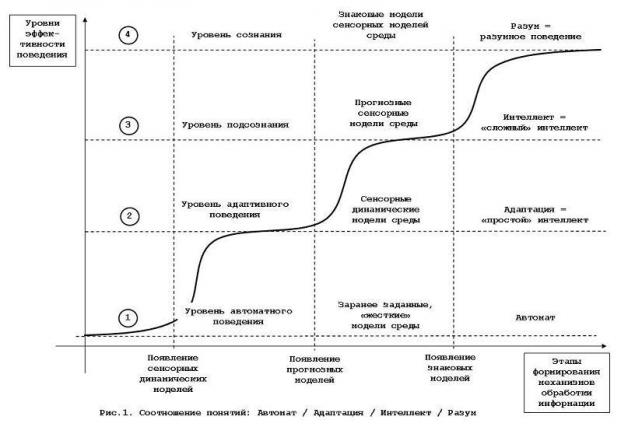
1. Level of FSM behavior. Characterized by "rigidly fixed" (static) behavior that conditions change varies little or no change. Characterized by a low stiffness and flexibility. The ability to modify (train) the weak and only in a narrow range of options. This level of behavior is typical for insects.
2. The level of adaptive behavior is the result of the formation of the sensory environment models. These models are generated dynamically, ie in the process of life. The mechanism of formation of such models - training. Adaptive behavior will just call the behavior of "simple" intelligence. This behavior is typical of amphibians and reptiles.
3. The level of subconscious behavior occurs after the onset mechanism capable of dynamically generate sensory forward environment model. In accordance with the theory of functional systems (TPS) [Anokhin] predictive intelligence provided acceptor properties of the result of action (ARA). It will be a system with a "true" intelligence that will just call systems with "complex" intelligence. An example may be the higher mammals. For the above reasons, it can be assumed that the cells of insects and there is no "intelligence". Never was and never will be.
4. The level of conscious behavior arises as a result of iconic models of sensory patterns environment. Ie sensory model "glued" label - a label or a label or mark, then it is possible to operate with reference to the model, not the sensor model. Sign system may be any of: graphic, audio, receptive (Braille), sign language, etc. Then we have the following chain:
The Real World - & gt; Touchscreen models - & gt; Signed model
Model model leads to further simplification of complex real-world objects, which allows him to learn more effectively. Known Pavlov thought that the word - light signals, whereby a person came second signal system, confirms this logic.
Outwardly, it looks like it, in one form or another. This also leads to the emergence of intelligent behavior and the phenomenon of consciousness, when aware of their thoughts and actions. They can be voice, to explain to another person, etc. Experiments with higher primates show that they possess protoconsciousness since successfully master the simple language. You can say that they are at the foot of the last "step" on the chart. For this reason, cats, amphibians and cells have no consciousness and can not be. The foregoing can be briefly expressed as follows:
1. (Automaton behavior) & lt; - Hard static environment model
2. (= Simple Adaptation intelligence) & lt; - Touch the dynamic environment model
3. (Int = Complicated intelligence) & lt; - Touch + ARA model (forecast)
4. (Mind = Consciousness) & lt; - Touch + ARD + model iconic models
This explains the difficulties in solving the problem of natural language understanding, and thinking person. This is due to ignoring the stages of sensory modeling and forecasting touch. Researchers immediately grab the higher functions, not realizing that they are based on lower-level primitives, forming, in the end, a hierarchical system models. Hence need for a phased work to implement these levels, significant interest of which represent levels №2 and №3. Implementation level №1 seems trivial. So it makes sense to consider what is known about the "constructive" understanding of the mechanisms of thought in the field of neurobiology, neuroanatomy, and psychophysiology. Here, under the "machinery of thinking" means the architectural concept of the general type.
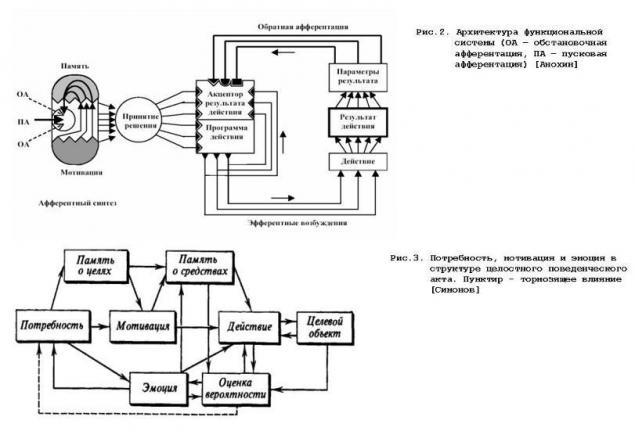

Figure 2 shows the behavior model, also known as the functional architecture of the system as part of TPS [Anokhin]. Figure 3 shows the model of behavioral act considering the needs, motivations and emotions [Simon]. With some analysis revealed that both famous scientists actually conduct depicted in the form of timing diagrams , and not as a static block diagrams, as is customary, for example, digital circuitry. There are other similar schemes, for example in Figure 4 [Redozubov] in Figure 5 [Zhdanov] and many others that just do not make a special clarity.
For example, if there is a block in Figure 2. "decision-making", then on Fig.3 and Fig.4 it is absent, there is a block in Figure 3 "emotions", as in Figure 2 is missing. The same can be said about the "scavenger result of action", "motivation", "Formation of memory", "Knowledge Base", "Formation of action", "Pattern Recognition", etc. Thus, from known sources is impossible to understand what is to be the technical architecture of the system, to provide the intellectual function in accordance with, for example, with a level of efficiency behavior №2. Hence it is clear that for the development of an architecture engineering approach is needed in view of the considered overall picture.
To be continued.
References
Alexandrov YI Psychophysiology. St. Petersburg: Peter, 2007.
PK Anokhin Fundamental questions of the general theory of functional systems // Principles of the system organization functions. M .: Nauka, 1973.
Velichkovski BM Cognitive science: foundations of cognitive psychology. M .: Sense, 2006.
Daniel N., Krylov AL The physiology of higher nervous activity. M .: Textbooks, 1997.
AA Zhdanov Autonomous artificial intelligence. M .: Bean, 2009.
Luria, AR Higher cortical functions of man. M .: MSU, 1962.
Redozubov AD The logic of emotion. SPb .: Amphora, 2012.
Samarin, AI Mobile robots and self-organizing neural structures - a retrospective look // From behavior to artificial intelligence. Ed. V.G.Redko. M .: URSS, 2006.
PV Simonov The emotional brain. M .: Nauka, 1981.
KV Sudakov Physiology. Fundamentals and functional systems. M .: Medicine, 2000.
VF Turchin The phenomenon of science: a cybernetic approach to evolution. M .: ETS, 2000.
Hubel D. Eye, brain, eyesight. M .: Mir, 1990.
Shvyrkov VB Introduction to objective psychology: the neuronal bases of the psyche. M .: Institute of Psychology RAS, 2006.
WR Ashby The design of the brain. M .: Foreign Literature, 1962.
Source: habrahabr.ru/post/220525/
Many amateurs are often born of thought on the subject, not previously acquainted with the existing body of knowledge. This is not surprising, because the degree of necessity of a source for understanding the nature of the intelligence is often difficult to determine. Information is scattered across different areas of science - a problem Intelligence is interdisciplinary, so a simple "programmer's" thinking does not work here. As a result, often born masterpiece "theory", the study of which only amazed naivety creators such opuses. The author is convinced of the infallibility of his "genius" point of view, proving her passionately. And nothing and no one can convince him otherwise.
So, the topic is interesting for its Intelligence inconsistency and confusion. There is mixed in a heap a lot of different concepts somehow related to each other. And here is how connected and how - to say clearly, no one can. What is intelligence? And how it relates to the mind and consciousness? This is the same or not? What is the subconscious? What is meant by thinking? Do cells have minds? Do intelligence in apes? What intelligence frog differs from intelligence bees? Or they have no intelligence? It is clear that such issues may arise million. Therefore considers it essential to define limits - what intelligence - and thus determine where it is and where it is not.
Int (from Lat. Intellectus - knowledge, understanding, reason), the ability of thinking, rational knowledge ... etc. In the web you can find many similar definitions, where it becomes clear that they give us a little. For example, from everyday notions can assume that dogs possess intelligence. But whether they have rational knowledge, is more difficult to say. And what is the rational knowledge? Viewing the moon through a telescope? Then do not have ... well, etc. Based on practice on the discussion forums, I met a lot of different opinions, sometimes very opposite.
For example, met the assertion that there is "animal" and "civilization" intelligence. Or "image-sensual" and "logical-abstract" types of intelligence. So, for example, that creative thinking can not be abstract. And what about Salvador Dali? Just some say that intelligence has only man, but all the animals only "adaptive behavior." Many prefer to equate: Mind = Consciousness = Mind. Some believe that consciousness begins with the cells. Or Intelligence begins with cells, but invest in their understanding of this term. There is also the theory of [Simon] that there is a subconscious mind, consciousness and superconsciousness. Last - it is a creative mind that can only be a unit. Or, for example, it is believed that the mechanisms (including electronic) is the intelligence, but very, very "small", the dog "more", and a man "very much." It turns out that intelligence is just kind of an elusive substance that is everywhere and nowhere ...
Before going further, it is necessary briefly to the notion of a model, which is crucial in the science of intelligence.
Model (lat. Modulus - «measure analog sample") - is a system, which serves as a research tool for information about another system , this is a simplified representation of a real device and / or occurring in it processes, phenomena ... In the Network and other similar definitions, but there is a need of clarification. General model can be understood by anything, even a paper boat. This may be the same, and the theory and formula, it just will be different kinds of models: physical, mathematical, formal, etc.
So, in our discussion, we have the model and be "different system" - Original. Will be the main assertions:
1) Original Model much easier;
2) The model contains "essential" properties of the original;
3) their "material" is defined The purpose for constructing models.
Without purpose is impossible to identify the "essential" properties of the original, and therefore without purpose and no models. In other words, Model - a look at the original in terms of Objectives. B> The trick is that because of the complexity of real objects, such viewpoints can be many and they are all true. Thus, there is a trio of interrelated concepts: Original Model and Target. Remember this.
A simple example shows that a frog that lives in the pond and a heron, which it hunts have different objectives and different resources to achieve their goals. Naturally also assume that the model of the same pond they are different. Does this mean that these models are not right? It does not mean, for that purpose will also be different. And what if the criterion of the adequacy of these models? The answer is obvious - the degree of achievement of objectives: the more effectively achieved the goal, the adequacy of the model.
Now back to the definition of intelligence, which sets out the following interesting. Int - the ability of the system to display the laws of the outside world and use them to achieve their goals [Samarin]. In my view, there is the phrase "the laws of the external world show" needs to be clarified and be replaced by "dynamically generate sensory environment model».
We now turn to Figure 1, where a graph of levels of efficiency behavior of living organisms, depending on whether they have those or other mechanisms of thinking. Schedule a spasmodic threshold character, like most natural processes. Obviously, the effectiveness of the jump appears after the appearance of a new mechanism of thinking.

1. Level of FSM behavior. Characterized by "rigidly fixed" (static) behavior that conditions change varies little or no change. Characterized by a low stiffness and flexibility. The ability to modify (train) the weak and only in a narrow range of options. This level of behavior is typical for insects.
2. The level of adaptive behavior is the result of the formation of the sensory environment models. These models are generated dynamically, ie in the process of life. The mechanism of formation of such models - training. Adaptive behavior will just call the behavior of "simple" intelligence. This behavior is typical of amphibians and reptiles.
3. The level of subconscious behavior occurs after the onset mechanism capable of dynamically generate sensory forward environment model. In accordance with the theory of functional systems (TPS) [Anokhin] predictive intelligence provided acceptor properties of the result of action (ARA). It will be a system with a "true" intelligence that will just call systems with "complex" intelligence. An example may be the higher mammals. For the above reasons, it can be assumed that the cells of insects and there is no "intelligence". Never was and never will be.
4. The level of conscious behavior arises as a result of iconic models of sensory patterns environment. Ie sensory model "glued" label - a label or a label or mark, then it is possible to operate with reference to the model, not the sensor model. Sign system may be any of: graphic, audio, receptive (Braille), sign language, etc. Then we have the following chain:
The Real World - & gt; Touchscreen models - & gt; Signed model
Model model leads to further simplification of complex real-world objects, which allows him to learn more effectively. Known Pavlov thought that the word - light signals, whereby a person came second signal system, confirms this logic.
Outwardly, it looks like it, in one form or another. This also leads to the emergence of intelligent behavior and the phenomenon of consciousness, when aware of their thoughts and actions. They can be voice, to explain to another person, etc. Experiments with higher primates show that they possess protoconsciousness since successfully master the simple language. You can say that they are at the foot of the last "step" on the chart. For this reason, cats, amphibians and cells have no consciousness and can not be. The foregoing can be briefly expressed as follows:
1. (Automaton behavior) & lt; - Hard static environment model
2. (= Simple Adaptation intelligence) & lt; - Touch the dynamic environment model
3. (Int = Complicated intelligence) & lt; - Touch + ARA model (forecast)
4. (Mind = Consciousness) & lt; - Touch + ARD + model iconic models
This explains the difficulties in solving the problem of natural language understanding, and thinking person. This is due to ignoring the stages of sensory modeling and forecasting touch. Researchers immediately grab the higher functions, not realizing that they are based on lower-level primitives, forming, in the end, a hierarchical system models. Hence need for a phased work to implement these levels, significant interest of which represent levels №2 and №3. Implementation level №1 seems trivial. So it makes sense to consider what is known about the "constructive" understanding of the mechanisms of thought in the field of neurobiology, neuroanatomy, and psychophysiology. Here, under the "machinery of thinking" means the architectural concept of the general type.


Figure 2 shows the behavior model, also known as the functional architecture of the system as part of TPS [Anokhin]. Figure 3 shows the model of behavioral act considering the needs, motivations and emotions [Simon]. With some analysis revealed that both famous scientists actually conduct depicted in the form of timing diagrams , and not as a static block diagrams, as is customary, for example, digital circuitry. There are other similar schemes, for example in Figure 4 [Redozubov] in Figure 5 [Zhdanov] and many others that just do not make a special clarity.
For example, if there is a block in Figure 2. "decision-making", then on Fig.3 and Fig.4 it is absent, there is a block in Figure 3 "emotions", as in Figure 2 is missing. The same can be said about the "scavenger result of action", "motivation", "Formation of memory", "Knowledge Base", "Formation of action", "Pattern Recognition", etc. Thus, from known sources is impossible to understand what is to be the technical architecture of the system, to provide the intellectual function in accordance with, for example, with a level of efficiency behavior №2. Hence it is clear that for the development of an architecture engineering approach is needed in view of the considered overall picture.
To be continued.
References
Alexandrov YI Psychophysiology. St. Petersburg: Peter, 2007.
PK Anokhin Fundamental questions of the general theory of functional systems // Principles of the system organization functions. M .: Nauka, 1973.
Velichkovski BM Cognitive science: foundations of cognitive psychology. M .: Sense, 2006.
Daniel N., Krylov AL The physiology of higher nervous activity. M .: Textbooks, 1997.
AA Zhdanov Autonomous artificial intelligence. M .: Bean, 2009.
Luria, AR Higher cortical functions of man. M .: MSU, 1962.
Redozubov AD The logic of emotion. SPb .: Amphora, 2012.
Samarin, AI Mobile robots and self-organizing neural structures - a retrospective look // From behavior to artificial intelligence. Ed. V.G.Redko. M .: URSS, 2006.
PV Simonov The emotional brain. M .: Nauka, 1981.
KV Sudakov Physiology. Fundamentals and functional systems. M .: Medicine, 2000.
VF Turchin The phenomenon of science: a cybernetic approach to evolution. M .: ETS, 2000.
Hubel D. Eye, brain, eyesight. M .: Mir, 1990.
Shvyrkov VB Introduction to objective psychology: the neuronal bases of the psyche. M .: Institute of Psychology RAS, 2006.
WR Ashby The design of the brain. M .: Foreign Literature, 1962.
Source: habrahabr.ru/post/220525/

